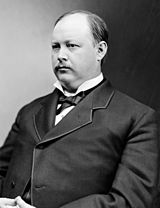United States House of Representatives elections, 1886
|
|
|||||||||||||||||||||||||||||||||||||||||||||||||||||
|---|---|---|---|---|---|---|---|---|---|---|---|---|---|---|---|---|---|---|---|---|---|---|---|---|---|---|---|---|---|---|---|---|---|---|---|---|---|---|---|---|---|---|---|---|---|---|---|---|---|---|---|---|---|
|
|||||||||||||||||||||||||||||||||||||||||||||||||||||
|
All 325 seats to the United States House of Representatives 163 seats needed for a majority |
|||||||||||||||||||||||||||||||||||||||||||||||||||||
|
|||||||||||||||||||||||||||||||||||||||||||||||||||||

Map of U.S. House elections results from 1886 elections for 50th Congress
|
|||||||||||||||||||||||||||||||||||||||||||||||||||||
|
|||||||||||||||||||||||||||||||||||||||||||||||||||||
Elections to the United States House of Representatives were held in 1886 for Representatives to the 50th Congress, taking place in the middle of President Grover Cleveland's first term.
As in many midterm elections, Cleveland's Democratic Party lost seats to the opposition Republican Party, although a narrow majority was retained. Many of these Republican pickups were in the industrializing Midwest states, where the debate over tariffs, which were advocated by Republicans to protect domestic industry but opposed by Democrats to allow for free agricultural trade, led to political change. The small Labor Party, supported by industrial workers, gained one seat each in Virginia (VA-06) and Wisconsin (WI-04), while the Greenback Party maintained its one seat in Iowa (James B. Weaver of IA-06). John Nichols was also elected as an Independent to NC-04.
...
Wikipedia




